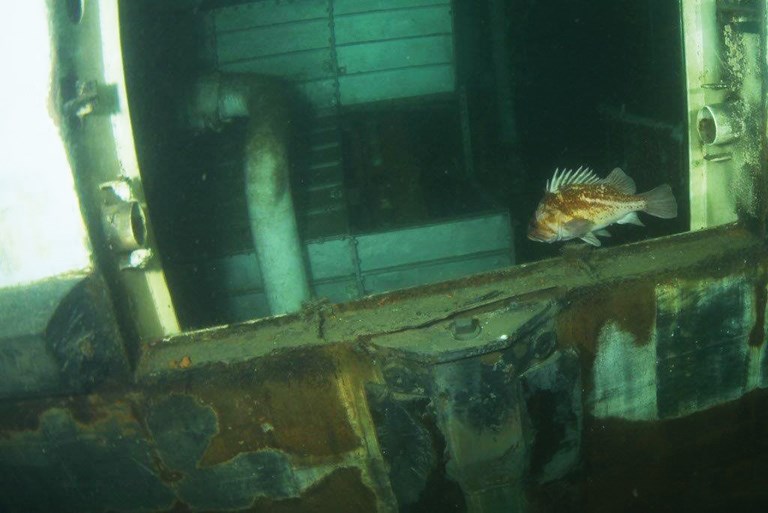A decommissioned warship sunk in Halkett Bay off Gambier Island in April is now seeing a steady stream of visitors of the human and non-human variety.
The 115-metre HMCS Annapolis became a popular dive site days after it sank, although it took a little longer for marine life to move in, according to Howard Robins of the Artificial Reef Society (ARSBC), which worked to sink the vessel.
Ocean life is now starting to creep into the Annapolis, signalling the start of what Robins expects will become a thriving artificial reef in Halkett Bay.
“We’re seeing shrimp on the vessel. We’re seeing rockfish exploring the vessel, some of them juvenile. We’ve got some crabs on there, starfish have started to crawl up and around,” Robins said, noting the beginnings of barnacles can also be seen in parts of the sunken ship.
“It’s very, very sparse, of course, but the building blocks are already starting and it’s actually happening quicker than I expected. I guess that’s attributed to the nutrients in the current that is so perfectly set up in the bay.”
He said he couldn’t give a timeline for when the artificial reef will be fully mature. “Nature does fill the void in its own time, in its own way. It’s a very progressive type of colonization.”
While exact numbers of divers visiting the site are hard to pinpoint, Robins said diving charter operators in the area have been “very busy.”
“I’m hearing reports of some charter operators going out twice a day, which is not unexpected, especially when it’s a new artificial reef. There’s a lot of curiosity, especially from the hundreds of people who worked on the vessel,” Robins said.
The HMCS Annapolis was sunk in Halkett Bay by the ARSBC on April 4, after six years of controversy around the plan, pushed mostly by the group Save Halkett Bay, that suggested the artificial reef would negatively impact the natural habitat of the area.
“Since the sinking, there has been absolutely dead silence from our opposition,” Robins said. “We’ve heard absolutely nothing.”
Requests for comment from Save Halkett Bay were unanswered by Coast Reporter’s press time this week.
Robins said there have been no issues with water contamination since the vessel sank, which was one concern of opponents.
“Nothing came out of that ship,” Robins said. “It’s completely as clean as a whistle, just as we had planned and just as we were required.”
Robins said the ARSBC will soon embark on a citizen-based study of the new artificial reef that will invite divers who visit the site to send in their photos and videos complete with date and time taken.
“It’s a long-term study called Project ABIS, which is an acronym for Annapolis Biodiversity Index Study,” Robins said.
“All the information and the data that we gather and dates of submissions will all be put into a storage area so that credible professional biologists can, at some point, go through the massive data and timeline all this and provide information about what’s happening in each year.”
A link to the ABIS study will be posted on the ARSBC website at www.artificialreef.bc.ca when it officially begins in the coming weeks.



